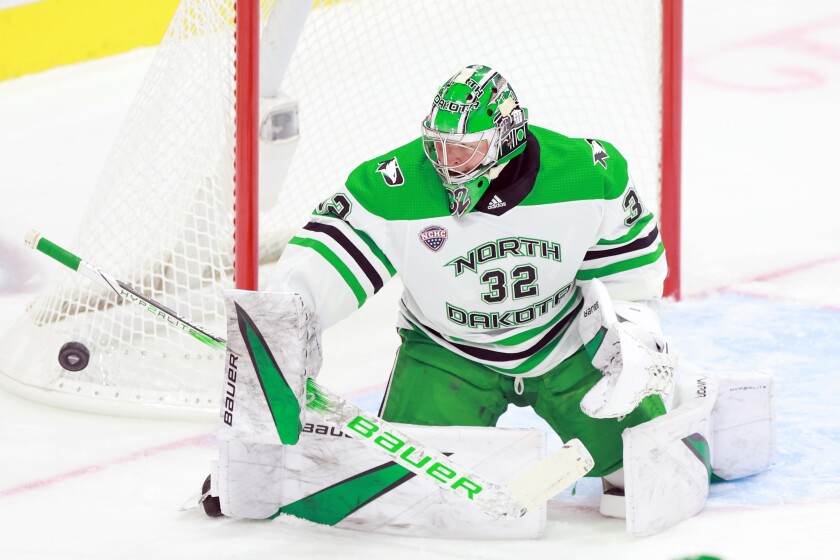GRAND FORKS — Karl Goehring is one of UND's all-time greatest goaltenders.
He was a two-time All-American, a Hobey Baker finalist, an NCAA national champion and still holds school records that stand today. He reached the NHL for a night with the Nashville Predators and spent eight years as a professional.
ADVERTISEMENT
If he came along again today, he might not even have a path to college hockey.
There's one reason: He's 5-foot-8.
The NHL trend of using large goaltenders is filtering down to other levels of hockey, including college, making it difficult for smaller goaltenders to even get considered.
Once, they were a staple of UND's program.
Darren Jensen, 5-foot-9, backstopped UND to NCAA titles in 1980 and 1982. Aaron Schweitzer, 5-foot-10, and Goehring won titles in 1997 and 2000.
Goehring was followed by 5-foot-7 Andy Kollar, 5-foot-9 Jake Brandt, 5-foot-11 Jordan Parise and 5-foot-8 Jean-Philippe Lamoureux, who was a Hobey Baker Award finalist as a senior in 2008.
But UND hasn't had a starting goaltender under 5-foot-11 since Lamoureux and they're disappearing across the country.
ADVERTISEMENT
Of the 61 primary starters in college hockey last season, only three were shorter than 5-foot-11 — Minnesota's Justen Close (5-10), Bemidji State's Mattias Sholl (5-10) and Michigan State's Dylan St. Cyr (5-8), who arrived in college six years ago and is now gone.
There were as many 6-foot-8 starting goalies as 5-foot-10 last season.
In the three Eastern-based college hockey leagues — Atlantic Hockey, Hockey East and the ECAC — there were 33 primary starters last season. Only one — Niagara's Chad Veltri — was shorter than 6 feet. He was 5-11.
"To me, it's a natural trickle down from the NHL," said Goehring, now a UND assistant coach. "This is something we see in a lot of areas of the game. When the NHL promotes a mindset or a shift, it's natural to trickle down to our levels and the youth levels. Certainly, you're seeing this trend. I definitely think it's a little more challenging, because of that mindset, for those guys who are undersized to get those opportunities."
The science behind it is simple.
Larger goalies take up more of the net. And nowadays, they're more refined and athletic.
"The bigger goaltenders sometimes have a knock of not being agile and just being blockers," UND coach Brad Berry said. "But in this day and age, with specialized coaching, bigger goalies are starting to excel at things that we look for."
ADVERTISEMENT
Starting in the NHL
As of Wednesday night, 54 goaltenders had played in the NHL this season.
Only one was shorter than 6 feet — Juuse Saros of the Nashville Predators. He's 5-foot-11 and broke into the league eight years ago.
Recent Stanley Cup champion goaltenders include Aidan Hill of the Vegas Golden Knights (6-foot-4), Darcy Kuemper of the Colorado Avalanche (6-foot-5), Andre Vasilevskiy of the Tampa Bay Lightning (6-foot-4), Jordan Binnington of the St. Louis Blues (6-foot-2), Braden Holtby of the Washington Capitals (6-foot-1) and Matt Murray of the Pittsburgh Penguins (6-foot-5).
It has been over a decade since a goalie shorter than 6-foot-1 has won the Cup. The last one was Tim Thomas for the Boston Bruins in 2011. He was 5-foot-11.
Because of that, some NHL teams won't even consider drafting smaller goalies. One NHL scout told the Herald any goaltender who isn't at least 6-foot-2 is considered "undersized" and is subject to deeper scrutiny.
College hockey hasn't quite gone to that extent, but it's slowly trending that way.
When the National Collegiate Hockey Conference launched in 2013-14, the eight starters had an average height of 6-0.5. This year's eight starters have an average height of slightly over 6-foot-2.
ADVERTISEMENT
"We don't need a kid to be 6-5," St. Cloud State coach Brett Larson said. "We have one right now in Dom Basse. But some of the best goalies I've seen in college hockey have been 5-11 or 6 feet. I think at the college level, the biggest thing I've seen is the kids who are the best goalies are the kids who compete. I'll let the NHL guys worry about the size. For us, it's those ultimate competitors that are going to help you win games. For me, if you're 5-10, fine. If they're 6-2, great."

Are smaller goalies being overlooked?
Are college recruiters putting too much of an emphasis on size?
The shortest starting goaltender in Hockey East last season was Northeastern's Devon Levi at 6 feet. He won the Mike Richter Award for a second-straight season as the best goaltender in college hockey.
Michigan Tech's Blake Pietila was tied as the second-shortest starter in the Central Collegiate Hockey Association last season. He was a finalist for the Hobey Baker Award.
Minnesota's Close, who will play in Ralph Engelstad Arena this weekend, has backstopped the Gophers to two-straight NCAA Frozen Fours as the second-smallest starting goalie in the nation.
"The trend is bigger, faster, more athletic," Minnesota goalie coach Brennan Poderzay said. "But at the end of the day, there are some goalies that are smaller who have an innate ability to have a high level of goalie IQ, who are able to read plays, able to use their athleticism, able to understand the structure the team is playing. If you're talking all things equal between a 6-2 guy and 5-9 guy, they're going to lean toward the 6-2 guy. But if the 5-9 guy has the high-end skillset, the size doesn't matter to me. What matters is the goalie foundation and what gives our team the best chance to win."
ADVERTISEMENT
In the NCHC, Colorado College's Kaidan Mbereko (.930) and Omaha's Simon Latkoczy (.933) had the top two save percentages in league play last season. They also were tied as the shortest goaltenders in the NCHC at 5-foot-11.
"It can be hard for a 6-6 guy to be Vasilevskiy when he's 18," Colorado College coach Kris Mayotte said. "It's a lot easier to control that body when you're 24, 25. I think we get the big guys at the college level, but their bodies aren't pros yet. There's a lot more to figure out. You look at Kaidan's body and how he moves and how he controls himself, he's just more athletic than most 6-5 guys can be. In time, that 6-5 guy may become Vasilevskiy, but it happens later. For us, we want the guys who are going to be good for us, not necessarily good for them."
Despite Mbereko's sensational freshman season and track record of success, he was passed over in last summer's NHL Draft due to his size.
That's not necessarily a bad thing for the school. It means the player might stay in college longer.
Minnesota State-Mankato and Minnesota Duluth recently parlayed that into major success.
NHL teams stayed away from 6-foot Minnesota State netminder Dryden McKay, who broke Ryan Miller's career NCAA shutout record, and 6-foot-1 Bulldog Hunter Shepard.
Both stayed in school four years. McKay led the Mavericks to the NCAA national championship game as a senior. Minnesota Duluth won two national titles with Shepard in net.
ADVERTISEMENT
"The bigger guys have a little advantage taking up space, but there's still room for guys who aren't pro-type goalies to be successful in college," Minnesota Duluth coach Scott Sandelin said. "I'm not looking for guys who are going to go pro. I want a guy who can be with me four years. Shep is a great example of that."

Trend in junior leagues
College coaches aren't often seeing small goalies on the recruiting trail.
The top developmental leagues also have gone with larger goalies.
The best junior hockey league in the country is the United States Hockey League. It opens each season with the Fall Classic in suburban Pittsburgh, where all teams meet and play twice in front of hoards of NHL and NCAA scouts.
Of the 24 goaltenders who played in this year's Fall Classic, none were shorter than 6 feet.
"From a market standpoint of what's available, there aren't a lot of 5-9 goalies out there anymore," Denver coach David Carle said. "It's not happening. I think, generally, the position itself is trending a little bigger — 5-11 plus in college and pro seems to be 6-2, 6-3 plus. But we don't have an internal benchmark that a guy has to be this height or this size or anything like that."
UND's future
UND's current goaltenders are all at least 6 feet tall — senior starter Ludvig Persson (6-0), freshman backup Hobie Hedquist (6-2) and sophomore third-stringer Kaleb Johnson (6-0).
The Fighting Hawks have one recruit lined up in highly touted Caleb Heil, who is 6-foot-1.
"Obviously, it's a benefit if a guy does have the frame," Goehring said. "But similar to a player, you're looking for IQ, how they read plays, their ability to anticipate and see what's coming at them. Like a player, you're looking for athleticism. Those are the things, for me, from an evaluation standpoint, that are important. When a guy has that IQ piece, has the ability to connect dots before plays are coming at them, it puts them ahead of the game."
UND went 20 years without a 6-foot starter — from Scott Brower in 1987-88 to Brad Eidsness in 2008-09.
But in the last 15 years, UND has had seven of them — Persson, 6-foot-3 Adam Scheel, 6-1 Cam Johnson, 6-2 Zane McIntyre, 6-2 Clarke Saunders, 6-0 Aaron Dell and Eidsness.
"Like anything in hockey, there are always certain shifts or trends," Goehring said. "This is one we're in right now. As a guy that's gone through it, my hope for players is their play and how they're able to impact games, is still one of the most important determining factors."
That leaves the original question.
Would Goehring and Lamoureux, who is still thriving at age 39 in the top Austrian league, be recruited by prominent Division-I schools today?
"I know they have qualities that would make them excel — their work ethic, their intelligence and their high-compete level," Berry said. "Those three things would allow them to keep rising to the top of rosters, I believe."
| Starter | Height | Years |
|---|---|---|
| Ludvig Persson | 6-0 | 2023-24 |
| Drew DeRidder | 5-11 | 2022-23 |
| Zach Driscoll | 5-11 | 2021-22 |
| Adam Scheel | 6-3 | 2018-21 |
| Cam Johnson | 6-1 | 2015-18 |
| Zane McIntyre | 6-2 | 2013-15 |
| Clarke Saunders | 6-2 | 2012-13 |
| Aaron Dell | 6-0 | 2010-12 |
| Brad Eidsness | 6-0 | 2008-10 |
| J.P. Lamoureux | 5-8 | 2006-08 |
| Jordan Parise | 5-11 | 2004-06 |
| Jake Brandt | 5-9 | 2002-04 |
| Andy Kollar | 5-7 | 2001-02 |
| Karl Goehring | 5-8 | 1997-01 |
| Aaron Schweitzer | 5-10 | 1996-97 |
| Toby Kvalevog | 5-10 | 1993-96 |
| Todd Jones | 5-11 | 1991-93 |
| Tony Couture | 5-9 | 1989-91 |
| Chris Dickson | 5-9 | 1988-89 |
| Scott Brower | 6-0 | 1984-86, 87-88 |
| Ed Belfour | 5-11 | 1986-87 |
| Jon Casey | 5-10 | 1981-84 |
| Darren Jensen | 5-9 | 1980-81 |
| Bob Iwabuchi | 5-9 | 1978-80 |
| Bill Stankoven | 5-10 | 1977-78 |
| Peter Waselovich | 5-9 | 1974-77 |









